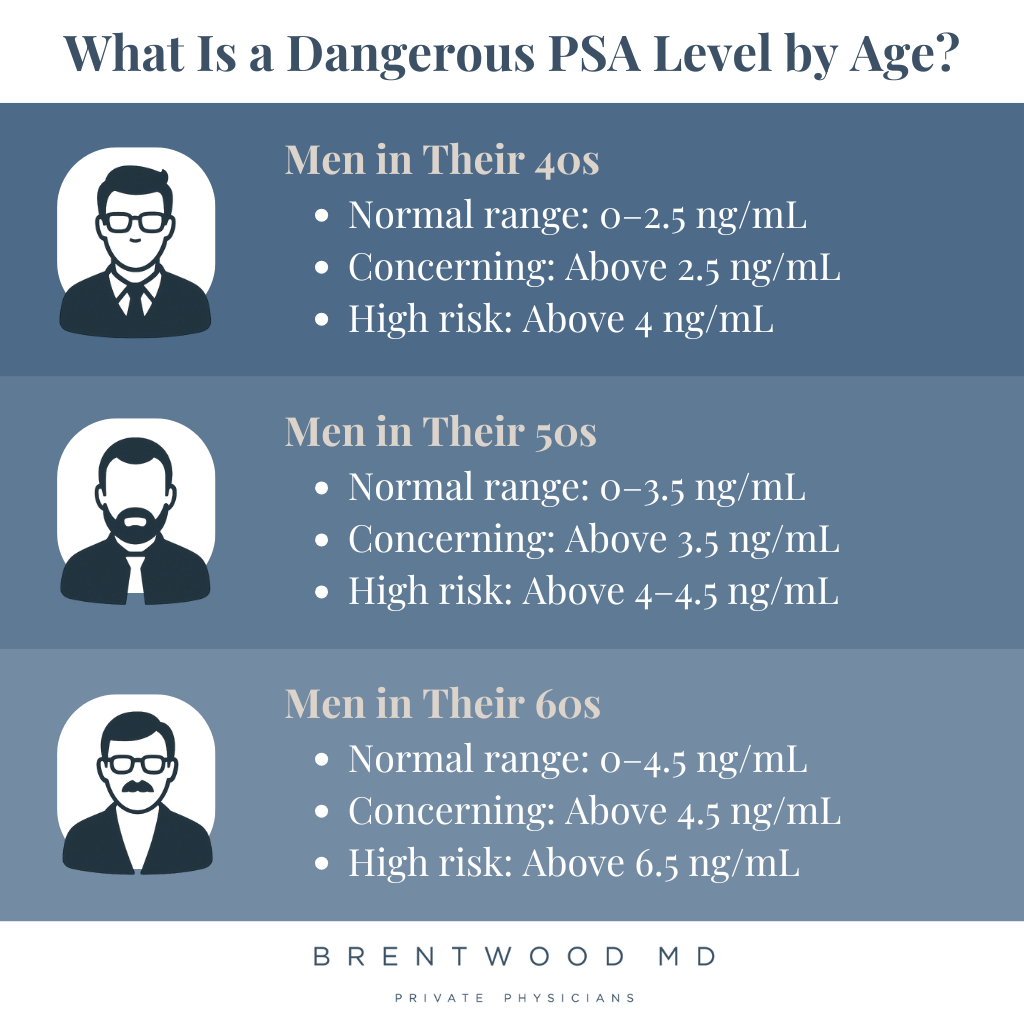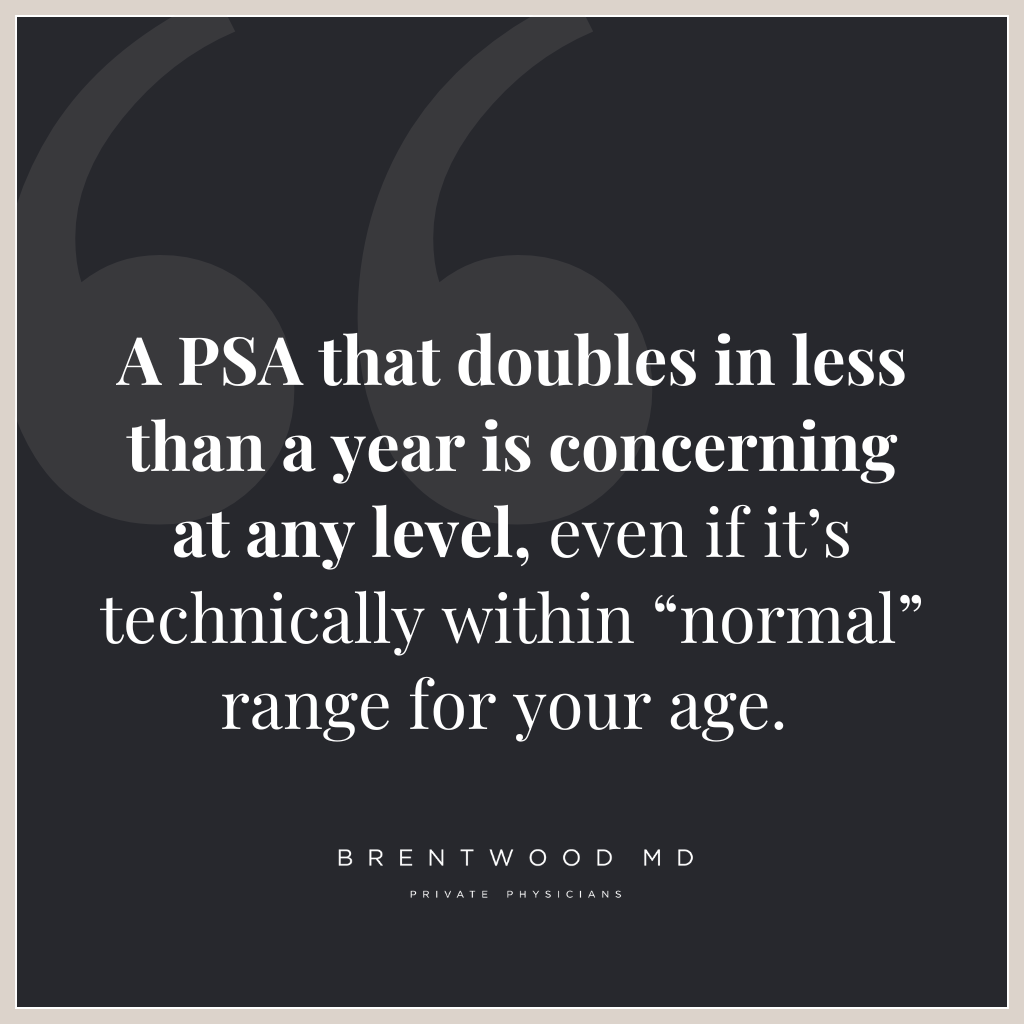You’re staring at your lab results, and there it is: your PSA level.
Maybe your doctor mentioned it briefly during your appointment, or maybe you’re researching on your own after getting the numbers back. Either way, you probably want to know what those results actually mean.
What do PSA results tell you? What is a dangerous PSA level by age? Is your number something to worry about?
Here’s the truth: PSA levels aren’t about hitting a magical threshold that either makes you safe or puts you in danger. It’s more nuanced than that, and understanding what your numbers mean could save your life.
So, let’s make sense of those results so you can understand when it’s time to take action.
Why PSA Levels Matter More Than You Think
A prostate-specific antigen (PSA) test measures a particular protein produced by your prostate gland. Think of it as an early warning system — not perfect, but one of the best tools we have for detecting potential prostate problems before they become serious.
Prostate cancer is the most common cancer in men, and the second-leading cause of cancer death in men. Projections estimate more than 310,000 men will be diagnosed with prostate cancer this year.
A man’s risk increases with age. By age 80, you have an 80% chance of developing some form of prostate cancer. But here’s what’s encouraging: When caught early through PSA screening, prostate cancer is highly treatable.
The key word there is early. A PSA test can detect problems years before you’d feel any symptoms. That early detection window is what gives you the best chance of successful treatment and maintaining your quality of life.
What Causes PSA to Rise (Besides Cancer)
PSA levels aren’t specific to cancer alone. Several non-cancerous conditions can raise your levels as well:
- Benign Prostatic Hyperplasia (BPH) — an enlarged prostate — is the most common cause of elevated PSA in older men. BPH affects most men as they age and can significantly increase PSA levels even though cancer isn’t present.
- Prostatitis — prostate infection or inflammation — can cause dramatic PSA spikes that resolve with antibiotic treatment.
- Recent prostate procedures, vigorous exercise, or even sexual activity within 48 hours of testing can temporarily elevate PSA levels.
For this reason, we don’t make major decisions based on a single PSA test result. It’s simply a bellwether, an indication that something may be happening. We then have to look deeper to discover what that “something” is.
Understanding PSA Levels: It’s Not Just About the Number
You might think PSA screening works like a pass-fail test. You’re either above or below some cutoff number, and that determines whether you’re in trouble. But that’s not how PSA screening works — or not how it’s supposed to.
Your PSA level should be evaluated based on several factors:
- Your age and baseline levels
- How your PSA has changed over time
- Your family history
- Your overall health picture
The old thinking said that a PSA under 4 ng/mL was “normal” and anything over 4 was concerning. We now know that’s far too simplistic. A man whose PSA jumps from 1 to 2.5 over a year may need investigation, even though he’s still under that “normal” threshold.
This is why I recommend every man over 40 get an annual PSA test. By getting a PSA level when your prostate is (likely) healthy, you establish a baseline against which we can measure your future results. The more data points we have over time, the better we can interpret what your numbers mean for you.
What Is a Dangerous PSA Level by Age?
PSA levels tend to naturally increase with age as your prostate gradually enlarges. That said, a healthy prostate will usually fall within certain general ranges:
Men in Their 40s
- Normal range: 0–2.5 ng/mL
- Concerning: Above 2.5 ng/mL
- High risk: Above 4 ng/mL
Men in their 40s should have the lowest PSA levels, and any elevation at this age warrants closer investigation. Though not common under age 50, prostate cancers that do develop tend to be more aggressive and serious.
Men in Their 50s
- Normal range: 0–3.5 ng/mL
- Concerning: Above 3.5 ng/mL
- High risk: Above 4–4.5 ng/mL
This is when PSA screening becomes critically important. More aggressive prostate cancers also show up during this decade, and early detection makes all the difference in the outcome.
Men in Their 60s
- Normal range: 0–4.5 ng/mL
- Concerning: Above 4.5 ng/mL
- High risk: Above 6.5 ng/mL
Your prostate naturally enlarges with age, so slightly higher PSA levels become more common. Rapid increases, however, demand attention.
Men 70 and Older
- Normal range: 0–6.5 ng/mL
- Concerning: Above 6.5 ng/mL
- High risk: Above 7 ng/mL
Even in older men, significant PSA elevations require evaluation. Prostate cancer becomes much more common at these ages, though they’re most often slow-growing. When caught early, they respond well to treatment.
Remember, though, it’s not just about staying below age-related thresholds. The rate of PSA change matters enormously. A PSA that doubles in less than a year is concerning at any level, even if it’s technically within “normal” range for your age.
Dangerous PSA Levels at Any Age
Regardless of your age, certain PSA levels signal immediate concern:
- PSA above 10 ng/mL represents a roughly 50% risk of prostate cancer and typically triggers urgent evaluation, including imaging and potential biopsy.
- PSA above 20 ng/mL suggests a very high likelihood of advanced or aggressive disease that requires immediate specialist attention.
The Modern Approach to PSA Evaluation
The days of rushing straight from an elevated PSA to a prostate biopsy are behind us, especially in a more personalized medical setting. Here’s how we approach PSA results at Brentwood MD:
Step 1: Evaluate the Trend
We look at how your PSA has changed over time. A gradual increase may be less concerning than a rapid spike, even if the absolute numbers are similar.
Step 2: Rule Out Simple Causes
If your PSA is elevated, we first check for infections that might be causing inflammation. Sometimes a course of antibiotics resolves the issue completely.
Step 3: Advanced Imaging Before Biopsy
Rather than proceeding directly to biopsy, we often order a prostate MRI first. This can show — down to about a millimeter of detail — whether there are suspicious areas that warrant closer investigation.
MRI-guided evaluation helps us avoid unnecessary biopsies while ensuring we don’t miss anything important. If the MRI shows concerning areas, then we proceed to targeted biopsy of those specific regions.
Taking Action: What You Should Do Now
If you’re reading this because you’re concerned that you might have a dangerous PSA level for your age, here’s a quick guide to next steps:
Get your baseline if you haven’t already. If you’re over 40 and have never had a PSA test, schedule one now. Regular cancer screenings are one of the most powerful tools you have for protecting your health.
Don’t panic, but don’t ignore your results either. Elevated PSA levels require follow-up, but they don’t automatically mean you have cancer.
Track your trends over time. A single PSA result tells us relatively little. Multiple results over time tell us a much clearer story about what’s happening with your prostate.
Work with a doctor who takes time to explain your results. I often say: Find your team. You deserve a healthcare team that takes the time to know you as a person, hear your concerns, and explain your individual results to you. If next steps are necessary, like repeat testing or imaging, you need a physician who will guide you through the process and make decisions based on your unique situation.
What Is a Dangerous PSA Level by Age? The Bottom Line
While highly elevated PSA levels are dangerous at any age, the evaluation of most men’s PSA requires context — like age, baseline level, rate of change, overall health picture — to interpret. This is why it’s important to find a healthcare team you can trust to take you and your individual health seriously.
Don’t let fear keep you from getting the information you need to live a long and healthy life. Whether your PSA levels are normal, concerning, or elevated, knowledge gives you power to act.
Your health is your greatest asset. Protect it by staying informed and working with a healthcare team that takes the time to help you understand what your results actually mean.

Dr. Aaron Wenzel is a concierge physician specializing in the care of fast-moving entrepreneurs, executives, and public figures in the Nashville, TN area. Dr. Wenzel’s diverse life experience and extensive training in family medicine, emergency care, nutrition, and hormone replacement therapies give him the unique platform to provide unmatched care for his patients.









